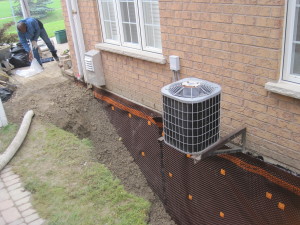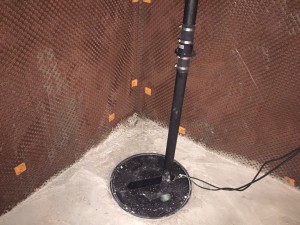22 Aug BASEMENT FLOOD PROBLEMS
Capillary Action
When groundwater comes up through the foundation and slab. This type of basement flood problems generally occur when the groundwater table is higher than the basement floor and foundation and can be somewhat offset by the use of a sump pump.
Leakage or Intrusion
Water leaking in through the basement walls and foundation, usual runoff from improper grading and drainage. This can be prevented by proper grading to aid water runoff and drainage away from the foundation, and by the application of a basement waterproofing product to the outer surfaces of the basement wall and foundation.
Sewage and/or Storm Drain Backflow
This is much less common than 1 & 2 above. This basement flood happens when water or waste materials come up through basement floor drains, a sink or bathtub drain or toilet, during heavy rainfall or snowmelt. This may mean that the city main is blocked or overwhelmed by the volume of water; as a result, wastewater is backing up into your drain line and home.
If you experience a backflow, call your local sewer or sanitation district immediately. Even if the cause of the backflow damage lies with the city or sanitation district, the homeowner must act quickly to manage the cleanup.
Unlike 1 & 2, a backflow can inflict serious damage, including flooding a room or an entire home. Sometimes, homeowners must move off the property during restoration. The cost of restoration after flooding and the hassle of dealing with insurance can be a major headache for homeowners.
General Solution for Any of The Three Basement Flood Causes
A properly installed, basement waterproofing systems. A sump pump with drain tile can greatly reduce the chances of getting water in your basement. Be sure to direct the discharge hose away from the house, out towards the street if possible. Otherwise divert it to a low point in the yard, clear of neighbours’ property. Discharge hose cannot cross city sidewalks. Periodically clean sump pit and check the operation of the pump. Ontario building code and City by-laws prohibit discharge into the sanitary sewer.
 Installing a complete basement waterproofing system during the construction process is highly recommended. Basement wall waterproofing, foundation waterproofing, and concrete waterproofing can all be done as a retrofit. However considerable excavation may be necessary to expose surfaces for application of waterproofing material, and obviously, this can become quite expensive.
Installing a complete basement waterproofing system during the construction process is highly recommended. Basement wall waterproofing, foundation waterproofing, and concrete waterproofing can all be done as a retrofit. However considerable excavation may be necessary to expose surfaces for application of waterproofing material, and obviously, this can become quite expensive.
The best-laid plan involves proper grading and drainage, application of a basement waterproofing product to seal exterior surfaces, and a sump pump system that can adequately handle fluctuating water tables at their peak levels.
Waiting until a problem is detected carries with it some consequences, and considerable damage will probably already have been done by this stage, including the formation of mould or mildew on surfaces or in basement framing.
This may necessitate recruiting a waterproofing contractor, who also provides mould remediation services to help with the basement flood problems.






No Comments